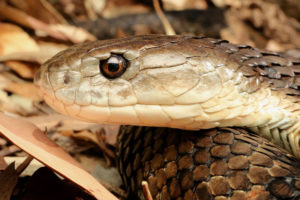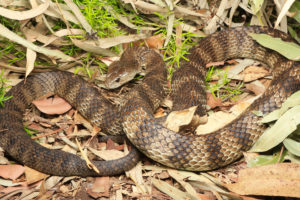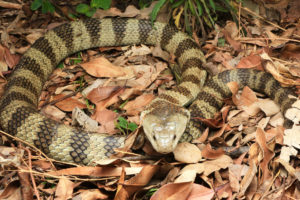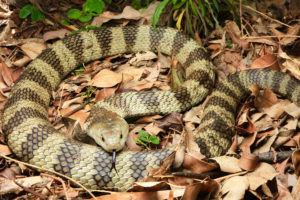Notechis scutatus scutatus
VENOM: Dangerously venomous, seek emergency assistance if bitten.
SIZE: Growing to 2m (Avg 1m)
LOCAL DISTRIBUTION: The Eastern Tiger Snake is not commonly encountered within South East Queensland. Queensland populations are confined to small pockets around the Sunshine Coast (By Beerwah), Bunya Mountains and the Gold Coast Hinterland.
HABITAT: Eastern Tiger Snakes primarily favour cool, wet areas where primary prey items such as frogs are abundant. These snakes are most commonly encountered in close proximity to natural water sources – especially swamps and creeks. Specimens have also been recorded in high altitude rainforests and heath land.
GENERAL DESCRIPTION: These snakes come in shades of brown to olive with numerous distinct bands of irregular widths covering the snake from the nape to tail tip. The banding on Tiger Snakes can vary from pale-cream to a copper-orange colour. These snakes are relatively stocky in build and have relatively large scales. The head of the Tiger Snake is characteristically broad and they will use this to their advantage when threatened; flattening the head and throat, similar to that of a cobra.
ADDITIONAL NOTES:
After each mating season, pregnant females will give birth to a liveclutch of 10 to 100 young.
SIMILAR LOOKING SPECIES: ROUGH SCALED SNAKE, EASTERN BROWN SNAKE, BROWN TREE SNAKE
It’s important to realise that many species of snake can vary in colour, pattern and size. This often makes it very hard to make a positive identification of the snake. You should always assume that a snake is highly venomous, keep your family and pets at a safe distance and call a Gold Coast snake catcher.



